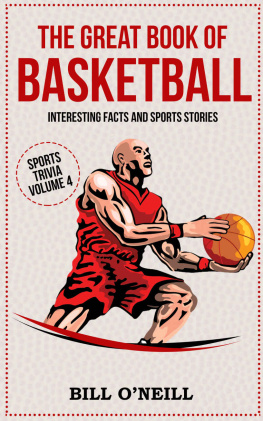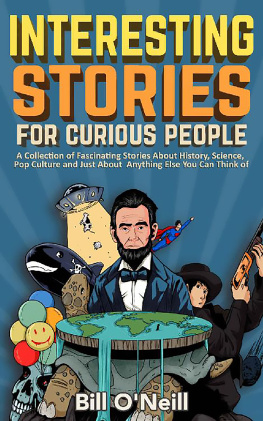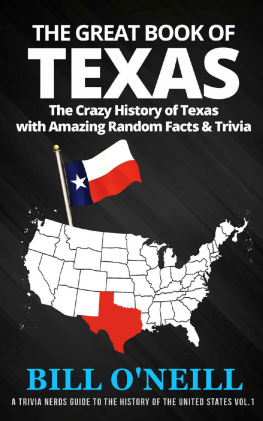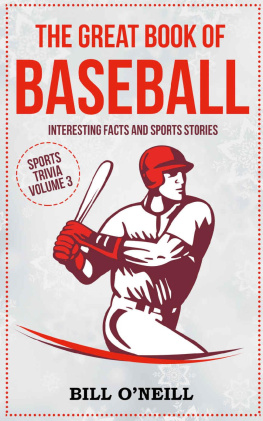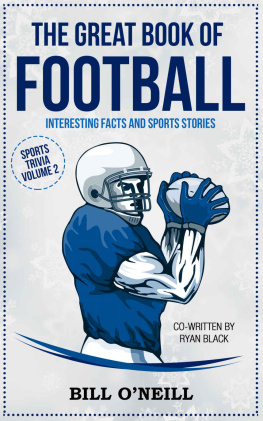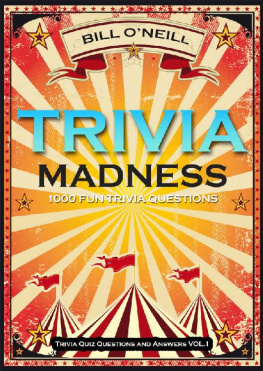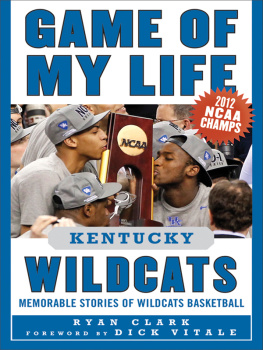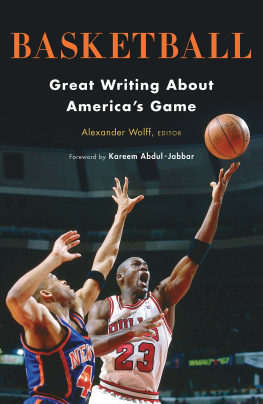The Great Book of Basketball
Interesting Facts and Sports Stories
Sports Trivia Vol.4
Bill ONeill
Copyright 2017 by LAK Publishing
ALL RIGHTS RESERVED
No part of this book may be reproduced, stored in a retrieval system, or transmitted in any form or by any means, electronic, mechanical, photocopying, recording, scanning, or otherwise, without the prior written permission of the publisher.
DONT FORGET YOUR FREE BOOKS

GET THEM FOR FREE ON WWW.TRIVIABILL.COM
Contents
Introduction
If youre a fan of basketball, youre in the right place. This book is chock-full of stats, tidbits and sometimes irreverent facts about your favorite NBA teams and players. This book could settle some arguments among your friends about whos the better player. This book could win you a drink at a bar when you pull out the random nugget of information to settle that bet.
This book will have some of the lesser-known back stories about those players and teams that everyone knows about. Youll learn about players who got along, and teammates who didnt. The quips and quotes of famous hoopsters, and hopefully, maybe some new perspectives of players from different eras throughout the history of the NBA.
Chapter 1 Back in the Day
While its easy to make fun of all that grainy black-and-white footage, what looks like sped-up film and unorthodox shooting styles, there were plenty of reasons the NBA of yesteryear was just as interesting as todays global brand as we know it. There were innovations, star players, dynastic teams, and a little bit of controversy along the way.
The Birth of a League
The NBA as everyone knows it today is far different than its first day of existence on Aug. 3, 1949. The National Basketball Association was actually the merger of two rival leagues, the Basketball Associated of America (BAA) and the National Basketball League (NBL).
The NBL was created in the mid-1930s, but known as the Midwest Basketball Conference. In 1937, it was changed to the National Basketball League. Corporate sponsorship took on a much bigger role in those days as Goodyear, Firestone and General Electric the original owner of NBC created the league.
What was originally an informal 10-game season among teams in Midwest cities grew quickly in popularity. The home team could choose the format of either playing in four 10-minute quarters or three 15-minute periods.
The NBL was unopposed until 1946, when the BAA originated. The big selling points for the BAA were they played in large cities, played 48 minutes instead of 40, allowed players a sixth foul and acquired players directly from college.
Both leagues were at risk financially trying to run the other out of business, but in 1949, representatives from both leagues met in New York City at the Empire State Building. There, they agreed to merge together to form the National Basketball Association as a 17-team league under BAA president Maurice Podoloff.
Maurice Podoloff
Podoloff himself is a unique character in sports history because he is the only man to run two professional sports simultaneously. He was also the president of the American Hockey League. Podoloff, though, is more widely known in basketball circles since the NBAs Most Valuable Player is awarded the Maurice Podoloff Trophy at seasons end.
Podoloff served as NBA commissioner until 1963, and the native of Ukraine was inducted into the Basketball Hall of Fame in 1974. The man in charge of some of the worlds tallest athletes was himself only 5-foot-2.
Danny Biasone and Leo Ferris
If Podoloff is to be given credit for running the NBA, Biasone and Ferris are the ones who arguably saved the league from extinction in the mid-1950s. Biasone was the owner of the Syracuse Nationals (todays Philadelphia 76ers), one of the original teams of the NBL and one of the seven teams that were absorbed into the NBA at the time of the merger.
The league struggled to make headway in the late 1940s, and by the early 1950s, it had contracted to eight teams. The slow pace of play and foul-filled contests after one team raced out to a huge lead turned off many fans, leaving the league in limbo. In the 1950-51 season, the Fort Wayne Pistons defeated the Minneapolis Lakes 19-18, and the teams combined for just four fourth-quarter points.
Biasone and Nationals general manager Leo Ferris tried out their idea for a shot clock during a scrimmage in 1954. Biasone felt an entertaining game in his view was when the teams combined to attempt approximately 120 shots. Ferris took the number of seconds (2,880) in a game, divided by 120, and thats how the 24-second shot clock was born.
George Mikan
George Mikan was one of the primary reasons Biasone devised the shot clock to speed up the game. Mikan, who averaged at least 20.6 points in each of his four NBA seasons as well as 13.5 rebounds per game the first four years the league tracked rebounds as a statistic, was a 6-foot-10, 245-pound giant who dominated in the paint on both ends of the court.
He used his long reach to shoot over smaller players and to block shots defensively, essentially serving as a one-man wall around the basket. In fact, Mikan was so good at blocking shots that the NBA had to create what is now known as the goaltending rule in which a player cannot block a shot while the ball is on its way down.
Offensively, Mikan had the rarest of skills, the ability score from close range using either hand. Anyone who has ever tried out for a high school basketball team at some point in their lives has done the Mikan Drill, in which a player shoot layups, alternating with each hand, and using the basket as a shield while not letting the rebound touch the floor.
Mikans Lakers won four of the first five NBA titles in league history and also set a precedent for the leagues penchant of having dynasties that continues to this day.
Red Auerbach
Forever associated with the Boston Celtics and his trademark victory cigars after winning a grand total of 16 titles as coach, general manager or president of the team, Auerbach got his start further south on the East Coast with the Washington Capitols in the BAA. He made the playoffs all three years there, but failed to win a title.
Auerbach also had a one-season stint with the Tri-Cities Blackhawks in the NBAs inaugural 1949-50 season. He went 28-29 and resigned after owner Ben Kerner traded away John Mahnken, whom Auerbach considered his best player.
Auerbach was hired by the Celtics mainly because then-owner Walter Brown asked for recommendations from the local media, and they suggested him. Auerbach is also credited with breaking down the NBAs racial barrier by selecting Chuck Cooper in the second round of the 1950 draft. Cooper was the first African-American to be selected by an NBA team, and by 2015, almost three of every four players in the NBA (74.4 percent) were African-American the highest of any major professional sports leagues in the U.S. and Canada. Auerbach is also credited with being the first coach to have a starting five of all African-Americans, beginning a game with Bill Russell, Willie Nauls, Tom Sanders, Sam Jones and K.C. Jones in 1964. He also made Russell the first African-American coach in North American pro sports when he tabbed the center as a player-coach for the 1967-68 season.
Bob Cousy
Auerbach was the architect of the second dynasty of the NBA, but one that lasted far longer with nine titles in a 10-year span. While almost everyone can tick off the names of the Celtics stars Cousy, Sharman, Russell, Sanders, Havlicek, Heinsohn, Ramsay and Jones Auerbach wasnt sold on Cousy at first.

